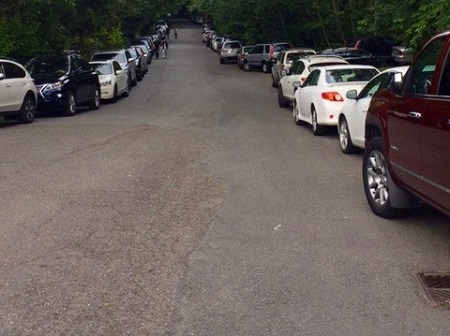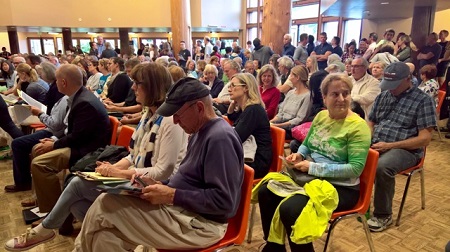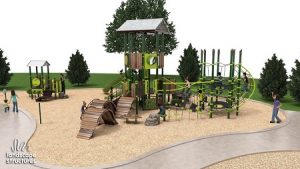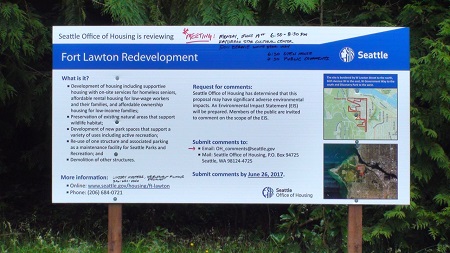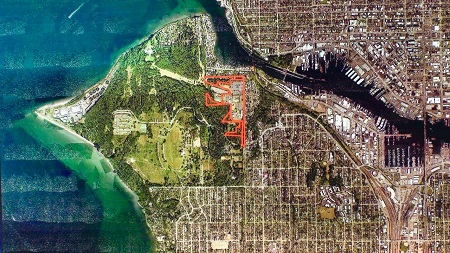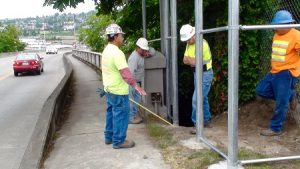By reporter Steven Smalley
Back in 2009 Elizabeth Campbell and company received good news. Their lawsuit against the City of Seattle prevailed when the State Supreme Court refused to hear the appeal of a lower Court’s affirmation of plaintiffs’ (her) claims. She was victorious by asserting various technical violations of the law against the bureaucracy that wanted to place homeless housing in the former Fort Lawton.
Eight years later, the City of Seattle is back with much the same plan. Historically, the City will line up various activists and pro-homeless organizations that want this proposal to go through, according to critics. Now Magnolia Voice interviews Campbell and other Magnolia homeowners who want no part of the City’s recurring proposal.
Also interviewed by Magnolia Voice, Emily Alvarado, the City of Seattle’s Policy and Equitable Development Manager at the Office of Housing answered many of the neighbors’ objections. What follows is the edited portions of those interviews.
The Magnolia Voice discussion included Gretchen Taylor, vice president of the Neighborhood Safety Alliance of Seattle; Cindy Pierce, president of the Neighborhood Safety Alliance of Seattle; and Elizabeth Campbell, director of the Discovery Park Community Alliance.
Magnolia Voice: Elizabeth, the Magnolia Neighborhood Planning Council filed a lawsuit against the city for failure to comply with its legal obligations under the State Environmental Protection Act and other violations. What happened?
Campbell: The City of Seattle failed to follow the State Environmental Protection Act process and the City had failed to comply with the Growth Management Act in relation to their overall plan.
MV: The City returns with a plan to install 85 units of homeless housing, 100 affordable rent apartments, and 50 low-end privately owned houses. I assume you want to stop this? Do you think you can?
Campbell: The City starts these projects, and if there’s any kind of pushback or legal process, they eventually return anyway. You never really get rid of them. The same thing happened on the tunnel, the waterfront, Mercer Street, and South Lake Union.
Emily Alvarado: The City’s vision in Fort Lawton is to have an affordable and livable community that creates more opportunities for those with low incomes who live in the Magnolia neighborhood. It does two things: It lets us find new opportunities for affordable housing for homeless and low income people in the midst of a housing affordability crisis, and it lets us take advantage of the property to create additional park space in our growing city.
Gretchen Taylor: This is a done deal. All that is left now is for the city to look like they’re following the plan they laid out. Step one: Environmental study. Step two: Community involvement. This is exactly what they did with the sewage treatment plant. We were sold on that plan. Look at the mess we are in.
MV: What’s the problem with the city’s homeless plan for Fort Lawton?
Campbell: There’s a certain homeless fatigue with these projects that the city is trying to pigeonhole into certain corners. It seems the they are trying to stick it to Magnolia. It’s something that’s not really thought out. This is off in a corner of the city without services, for example.
MV: How about the example of the homeless encampment behind QFC on Dravus Street? Is this the law of unintended consequences? Describe the situation in that area.
Cindy Pierce: You have a tent city that supposed to be free of alcohol and “clean.” When we visit them without cameras and politicians in tow, the residents are honest with us. They let us know there are drugs and alcohol. The problem with the tent cities, it draws in RV’s and other homeless individuals. There’s a lot of drug dealing going on. Another problem is the large grocery stores in the area have indicated that shoplifting is at a minimum of $1,000 a week.
Taylor: The garbage is part and parcel of the area whenever we see homeless who set up camp. Mayor Ed Murray himself said that a minimum of 80% of the homeless on the streets are addicts. The city takes a Band-Aid approach, so it looks like something is being done to appease voters. Plus, it’s a career building move for employees in the Parks Department, and others in city government. Bureaucrats want to look like they’re doing something to pack their resumes: safe injection sites, homeless projects, navigation center. What they do is target something they want to fix, and then they fix that one thing. Housing in Fort Lawton would be that little fix. They’re trying to sell us a bill of goods.
Alvarado: The environmental impact statement will include an alternative that looks at off-site affordable housing at an alternative location. The proposed off-site location for study in the environmental impact statement is the Talaris campus on Northeast 41st Street. The distinction there is that that land would have to be purchased at fair market value. The key opportunity here is that the Fort Lawton property is an eligible conveyance. We can access the property at potentially no cost for uses like homeless housing or affordable home ownership. Our office has a 35-year track record of investing in affordable housing and permanent supportive housing across the city in many of the city’s neighborhoods.
Campbell: You have to look at the fact that this is a moneymaking proposition. When the City does a big project, they’re able to skim off a certain amount of money that goes to either sustaining or expanding their bureaucracy. Also, there’s a lot of money that goes to consultants. It’s the same consultants project after project. Those people stand to make a lot of money. Then, the next level of money goes to these so-called non-profits. The non-profits of today are not like the old days of charity work. The non-profit of today is virtually a for-profit company. They have managers, staff, overhead – the more projects they can do, the longer they will stay in business. That’s why you don’t see an end to some of these social problems. This is big money.
Alvarado: There is a public process. We have a vision for homeless opportunities for affordable housing and park space. We hear comments from a range of people including community members who do not want to see affordable housing in the location, and community members who do want to support homeless and low income residents in the community. All of those comments will be weighed and we will undergo the environmental impact study process, and community members will have the final opportunity to provide comment to their elected officials.
MV: Some critics of the City’s redevelopment plan say this homeless population will add to additional security risks in Discovery Park. What is the overall climate of personal safety now in the park? People tell us they are literally afraid to go there. What’s your assessment?
Taylor: It’s almost unnerving to walk in certain areas because you never know what you’re going to encounter: Someone doing drugs, human feces, tents with scary individuals. As a woman alone, I would not walk in Discovery Park.
Pierce: I wouldn’t even park my car there. That’s how bad it is. I’m afraid if they saw just some change in my car they would break in.
Alvarado: Next week we are beginning an opportunity to have additional public engagement and public input. We are building off of an extensive public process that took place during the original plan-making period. It’s really clear the community cares very much about the future of this land. We are responsive to community members and we also want to be responsive to some of the critical needs our city has, like creating affordable housing and supporting a homeless population that is growing right now.
MV: An opinion piece in The Seattle Times suggests the Magnolia/Queen Anne/downtown high school, now proposed to be built near Memorial Stadium, should be constructed on the Fort Lawton property. The writer cited the inadequate size of the Seattle Center property and the Mercer Mess as factors to take into consideration. What are your thoughts?
Elizabeth: Pragmatically, if I’m faced with the decision of this proposed housing versus a high school, then I’m going to opt for the school. It’s a fallback position. If I can’t have a park and must be faced with an active use, the school is a better use.
Gretchen: I want a park, but I can support a school. Because open spaces teach children about nature and the importance of preserving natural ecosystems.
Alvarado: We are in touch with the Seattle public schools given those incoming comments, and understand that they have their own process for how they identify properties for acquisition. They can be contacted directly, but we are in coordination with them. Also the environmental impact statement will study the impact on the enrollment in schools with this proposed development or the other alternatives.
MV: Some will call critics of the City’s proposal NIMBYs (Not In My Backyard), or anti-homeless, or simply against the poor, how do you answer the name calling?
Taylor: I don’t believe that wanting open spaces is NIMBY-ism. A Band-Aid approach to fix a social problem only to look good on a resume is not going to serve future generations. Let’s protect the jewel of the city. It is dear, it is precious, and once given away, it’s gone.
Elizabeth: We shouldn’t need to defend ourselves from being called NIMBYs. The moniker is tired, trite, and contrived.
Magnolia Voice: Additionally, there are no services nearby for those who would live in these housing units. It’s such a long distance to any amenities. The Metropolitan Market isn’t conducive to low-income shopping. Do you have plans that you have not spoken about?
Alvarado: The concept is to pair affordable housing with tailored supported services that are designed to meet the needs of the resident population. In many cases that includes on-site case management and could include other supports like transportation services, meal support, or other tailored support. Catholic Housing Services as the housing provider would design a program in the supportive homeless housing building that supported those residents.
MV: Is the only way for residents who oppose this project to take the City to court as they did eight years ago? It seems like an expensive proposition.
Alvarado: I hope they wouldn’t have to. We are providing opportunities for input on the alternative we will be studying. There is opportunity to send us written comments; to email us with comments. There will always be opportunities to contact council members on their approval and what they do with the plan. Email:
oh_comments@seattle.govVoice: What’s next? Will the city listen to those who are opposed to this?
Pierce: They didn’t listen to us when we didn’t want the tent city in Ballard. They didn’t listen to us when we didn’t want the tent city in Interbay. The only thing that’s going to stop the City’s plan in Fort Lawton is the power of the people.
Campbell: I think it has to be a legal approach. This is the way to tackle the City. You need a lawyer and a litigation plan – you need to go guerrilla. To me it’s like a war. You use the tools you have available. This city knows they can ignore the people because no one will come after them legally. I’m for taking a hard stand with the city. That’s what I think they understand.
Taylor: We need to take a stand and say the city can’t railroad us.
MV: What is the point of the two meetings coming up Monday [June 19, 6:30 p.m., Daybreak Star] and Wednesday [June 21, 6:30 p.m., Magnolia Community Center]? What can we expect?
Alvarado: At the meeting will have an open house where community members can ask questions to the Office of Housing, the Parks Department, and to our community partners about the proposed alternatives, and about the environmental impact statement process. We will have an opportunity for people to provide comments, and we will provide a short presentation on the environmental impact process and what alternatives are being studied. All of the materials presented will be on our website for anyone to see. www.seattle.gov/housing
Pierce: I want people to show up. I’ve started talking to my neighbors.


